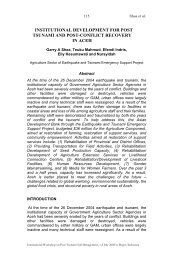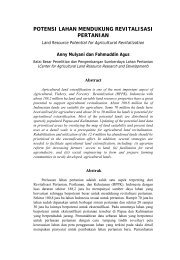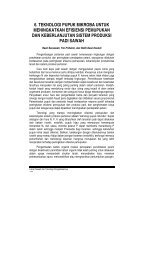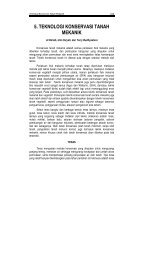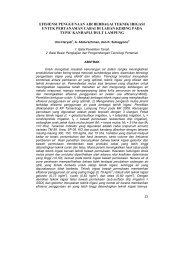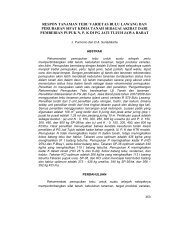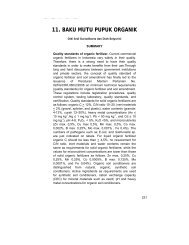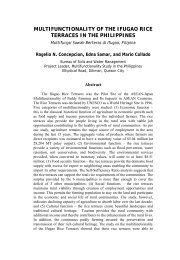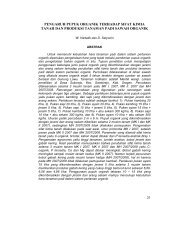Proceedings - Balai Penelitian Tanah
Proceedings - Balai Penelitian Tanah
Proceedings - Balai Penelitian Tanah
Create successful ePaper yourself
Turn your PDF publications into a flip-book with our unique Google optimized e-Paper software.
51<br />
DYNAMICS OF TSUNAMI-AFFECTED<br />
SOIL PROPERTIES<br />
Achmad Rachman 1 , I G. M. Subiksa 1 ,<br />
Deddy Erfandi 1 and Peter Slavich 2<br />
Rachman et al.<br />
1 Indonesia Soil Research Institute, Jl. Ir. H. Juanda 98 Bogor 16123<br />
Indonesia, 2 NSW Department of Primary Industries, 1243 Bruxner Highway,<br />
Wallongbar NSW 2477 Australia<br />
Abstract<br />
Seawater inundation after the tsunami on December 26, 2004<br />
changed the soil chemical properties of agricultural land along the<br />
coastal areas of Aceh, Indonesia. It was approximated that 90,000 ha<br />
of paddy fields, 25,000 ha of mixed gardens, and 90,000 ha of estate<br />
crops were inundated. The objective of this study was to study the<br />
changes in soil chemical properties on the selected areas affected by<br />
the tsunami and access constraints to crop performance. Twenty<br />
monitoring sites have been established to regularly assess soil<br />
chemical properties and crop performance. Crops which have been<br />
assessed include rice, corn, peanut, soybean, onion and chillies. At<br />
each site, composite soil samples were collected from 4 depths at 20<br />
cm interval for selected soil chemical analyses. The level of soil<br />
salinity in tsunami-affected areas appears to be related to the duration<br />
of inundation by the sea water and the permeability of the soils. Soils<br />
that were inundated for up to 6 days after the tsunami appear to be<br />
more saline compared to those inundated for only 1-3 days. In most<br />
areas, soil salinity has returned to normal levels within less than one<br />
year period especially in areas with relatively high rainfall, sandy soils<br />
or peat soils. However, in areas where lateral water flows are<br />
prevented by damaged drainage systems, salinity is still too high for<br />
most crops (ECe>4 dS/m). Where farmers had access to irrigation<br />
water, the vegetative growth of rice crops established after the<br />
tsunami appeared unaffected, but grain formation has been severely<br />
affected causing up to 50% yield loss. The lack of grain formation on<br />
rice and empty pod of peanut appeared to be related to high soil<br />
salinity that cause osmotic stress and nutritional imbalance. The low<br />
Ca/Mg and K/(Ca+Mg) ratios,



